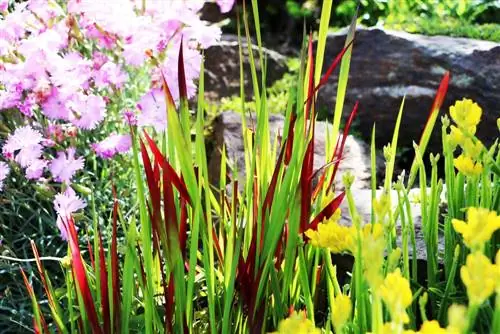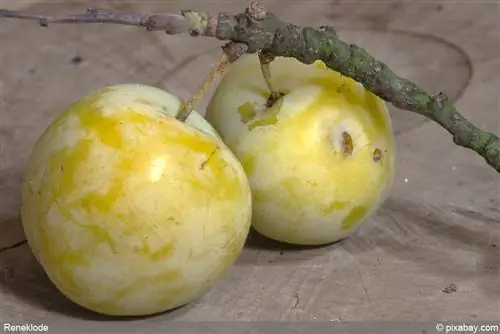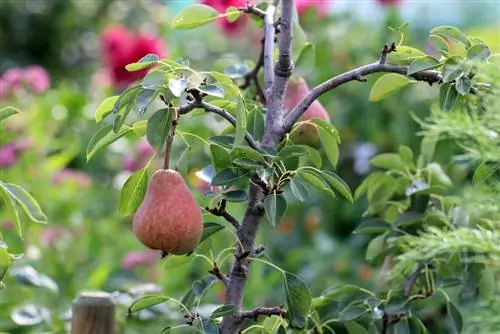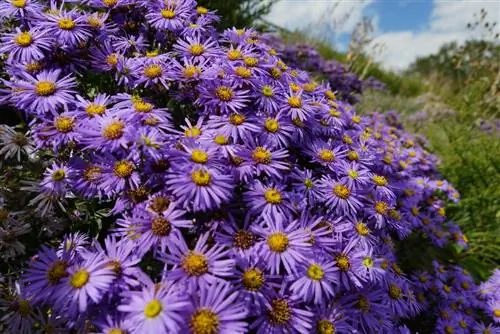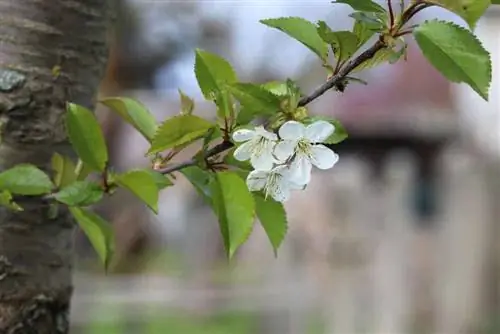- Author admin [email protected].
- Public 2023-12-17 03:39.
- Last modified 2025-01-24 12:45.
The dwarf blood plum is a compact ornamental shrub with a special charm, characterized by dark red foliage, pink spring flowers and bright red fruits in autumn. Creative hobby gardeners like to cultivate the tree as a neat little trunk in a pot, as the height of 2 meters is rarely exceeded. At the same time, the Prunus cistena demonstrates its robust undemanding nature, as it is considered exemplary in terms of its heat and cold tolerance. The following instructions for care and cutting provide you with detailed, practical information about all relevant aspects.
Location
The dwarf blood plum owes its remarkable resilience to the wild cherry plum from which it emerged. This thrives in the wild along forests or in orchards, where it can cope with different soil qualities. The wild species passed this talent on to its cultivar, so that the description of the suitable location can be broad.
- Sunny to semi-shady location
- Like to be sheltered from the wind and warm
- Permeable, nutrient-rich soil
- Fresh, moist and humus
Since this description applies to the classic ornamental and kitchen garden in general, the aesthetic perspective can come to the fore when choosing the location. Planting in pots gives you additional scope if the local conditions are reduced to suitable light and temperature conditions. We recommend a structurally stable pot plant soil as a substrate, optimized with compost, horn shavings and a few handfuls of perlite.
Watering and fertilizing
In the year of planting, the dwarf plum requires a higher level of care attention than in later years. Watering depending on the weather is the top priority during the growing phase. In terms of nutrient supply, the ornamental tree is rather modest. These aspects are important:
- Water young Prunus cistena abundantly and regularly in dry conditions
- Water established trees only when there is no rain
- Make sure there is a constant supply of water in the bucket
- Administer a slow-release fertilizer in March, supplemented with a flower fertilizer in May
- Alternatively, fertilize organically every 2 weeks from March to August with compost and horn shavings
For potted plants, we recommend using liquid fertilizer for flowering trees in the dosage according to the manufacturer's instructions. Alternatively, fertilizer sticks or cones can be used, which usually have to be refreshed every 6 to 8 weeks.
Cutting
The individual characteristics include slow growth of 10 to 20 centimeters per year. Regardless, annual pruning and shaping is advisable. In this way you maintain the shapely silhouette and create space for new shoots. In addition, professional pruning has a beneficial effect on the abundance of flowers and the autumn fruit. The choice of date is determined by the desired goal of the nursing measure. If the pruning takes place immediately after flowering, this choice of date will be to the detriment of the abundance of fruit and in favor of the next bloom. If you cut the tree into shape in late winter, many buds will be lost because they were already planted the previous year. The incision is made according to this pattern:
- Choose a date with overcast, dry weather
- Thoroughly thin out the shrub by cutting off dead wood at the base
- Cut out all dead branches from the crown of the trunk
- Completely remove inward-facing shoots
- Remove stunted and steeply growing branches
- Cut back dead branches by a third
Place the cutting tool at a slight angle so that the cut is made just above a sleeping eye. In this way you encourage the tree to branch out further and develop a compact habit. Whole branches are cut to astring. This means that no stubs are left on the trunk. At the end of the shape and maintenance pruning, the dwarf plum is so airy that the sun's rays can penetrate into all areas. Individual corrections can be made throughout the year, provided it does not freeze.
Tip:
Tearing off wildlings and water shooters sprouting from the rootstock on refined stems with a courageous swing prevents unwanted sprouting for a longer period of time than a simple cut.
Wintering
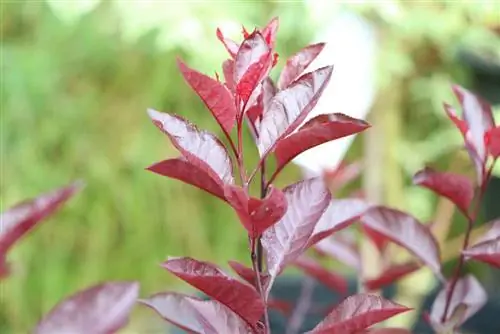
Even the lowest temperatures cannot harm the deciduous ornamental and fruit trees in the bed. Light winter protection is only recommended in the year of planting. The tree disc is covered with a thick layer of leaf mold, brushwood or straw. The young branches are given a cap made of fleece or jute. If temperatures permanently exceed the frost line in spring, the winter protection is removed so that condensation and rot cannot form underneath. If you cultivate a Prunus cistena in a bucket, it requires annual protection measures so that the root ball does not freeze. What is harmful here is not the frost itself, but the fluctuating temperature. The tissue cells cannot cope with a repeated change from freezing to thawing and burst. Such hardships rarely occur deep in the ground. In the exposed position of a planter, they are one of the most common dangers. How to effectively prevent forest damage:
- Place the planter on a thick disc of cork or a block of wood
- Cover the bucket with bubble wrap in several layers
- Spread leaves, straw or needles on the substrate
The wood is now particularly grateful for a spot in front of the protective south wall of the house. In addition, watering the shrub or trunk on forest-free days, as long as there is no snow, will contribute to successful wintering.
Diseases and pests
Professional care combined with annual pruning and maintenance creates a resilient plant that is able to fend off attacks from diseases and pests. However, if there are minor or major failures, the blood plum is weakened to such an extent that fungal spores, viruses and parasites have an easy time of it. In addition, cold, damp weather has a negative impact on your he alth, regardless of careful care. The following issues have been frequently observed:
Fool's disease or pocket disease
The ascomycete fungus Taphrina pruni causes unnatural growth due to uncontrolled cell proliferation. This manifests itself in atypically shaped fruits that appear elongated or curved. After initially thriving with a smooth skin, a floury-white patina develops towards the end of May. As the process progresses, the plums shrivel, turn an unappetizing brown-purple and fall off. What is typical for this disease is that no stone forms inside the fruit. There is currently a lack of effective fungicides for home and allotment gardens. These control and preventive measures are available:
- The complete removal of all infected plant parts in the early infestation stage
- When pruning annually, ensure a loose, airy crown structure
- The quicker the leaves dry, the lower the risk of infection
- Do not dispose of clippings and fruit mummies in the compost
Monilia fruit rot
This fungal infection only strikes when the dwarf plum is already proudly displaying its bright red fruits. Round, brownish areas of rot form. The spores penetrate the cherry plums completely, causing them to rot and fall to the ground. These defense options are available:
- Remove all infected plums at the first sign
- Do not dispose of in the compost, but in household waste
- Set traps for wasps so that they do not hurt the fruit by stinging them
- Consistently prune every spring after flowering
- To strengthen, treat with horsetail broth or liverwort extract from February
Aphids
Just in time for the beginning of spring, they are lurking everywhere again, the black, green and brown aphids. Initially unnoticed on the undersides of the leaves, they spread explosively over the entire tree and suck the life out of the leaves. This is how you take action against the pests:
- Hose the bush or tree with as strong a jet of water as possible
- Then spray repeatedly with a milk-water mix in a ratio of 1:9
- If the infestation pressure is high, make a decoction from tobacco residues and apply it
A broth made from 500 grams of nettle leaves and 5 liters of water has proven to be an effective, environmentally friendly control agent. This should steep for 24 hours, then simmer for 20 minutes to be used after it has cooled until all aphids have been eliminated.
Conclusion
Creative hobby gardeners who want a colorful and at the same time undemanding ornamental tree are well advised to choose a dwarf blood plum. In order for the purple foliage, the delicate pink flowers and the red fruits to thrive, only a little care is required. Regular watering in dry conditions and fertilizing from March to August create the basis for magnificent growth. Supplemented with annual pruning, the Prunus cistena will not cause you any headaches.


